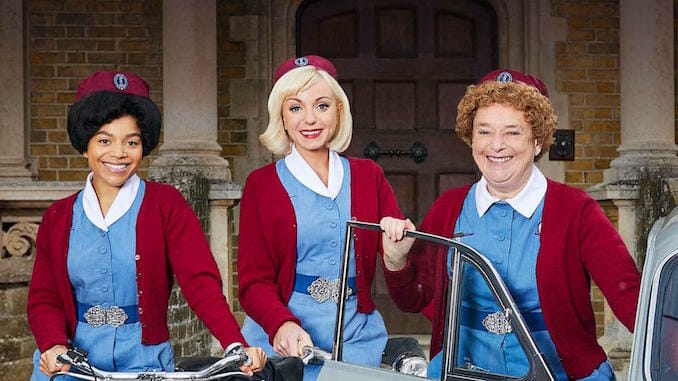4 Reasons Call the Midwife Is Still One of TV’s Most Comforting Shows
Photo Courtesy of PBS
The words “cozy” and “comfort” may not be what immediately come to mind about a drama revolving around midwives and nuns birthing babies and helping people who live in abject poverty in post-war East London. And yet, that’s exactly what the enduring UK drama Call the Midwife delivers.
The series focuses on the midwives of Nonnatus House, who ride bikes to deliver babies at patients’ homes and deal with important women’s health issues and medical breakthroughs of the day, from the introduction of the pill to birth defects from thalidomide. Set in 1960s Poplar, where most people lived in tenements, these nurses provide an essential service in the community.
With Season 10 just having debuted, it feels like the Call the Midwife always arrives just in time for those of us who need comfort and an escape to another time and place (Season 9 debuted in March of 2020, for example). As soon as one season ends, the countdown begins for more of one of TV’s best and coziest dramas.
Which is why now is as good a time as any to reflect on why this show means so much to so many around the world, and why it inherently offers that sense of comfort in each episode. Whether you’re curious about the series and want to start watching, or you’re a dyed-in-the-wool fan wanting to celebrate the series’ comforting sweetness, here are 4 reasons we love Call the Midwife:
![]()
The Coziness of Nonnatus House
When patients call the midwife, it rings on a phone in Nonnatus House. The show’s focal point, where midwives live with Anglican nuns, makes you almost want to be in this small community amongst them. Even though they’ve faced various tribulations, there’s a feeling of safety in this small world where its inhabitants all have a clear raison d’etre, which is to be of service. The main characters are so compelling that we can’t wait to catch up with them year after year. That dynamic is especially strong in the scenes when they’re at the house together, particularly during meals. It makes you want to sit beside them and have a cup of tea—or at night, in the earlier seasons with Sister Evangelina (Pan Ferris) and “Chummy” (Miranda Hart), perhaps a cup of Horlicks.
It’s a Time Machine 
Even though Call the Midwife is set in a bygone era, creator Heidi Thomas’ soulful writing showcases commonalities we all relate to, whether from life’s challenges (such as poverty, illness or substance abuse), falling in love (or the lack of it), or trying to find a better life within one’s circumstances.
Vanessa Redgrave narrates the series as the voice of Jenny Lee, who looks back at these events from her elder years. The show was inspired by Jennifer Worth’s true-life book series, and though actress Jessica Raine (who plays Jenny in her younger years) left the series after Season 3, Redgrave’s narration continues to document the happenings of Nonnatus House. And from there, for an hour, we’re transported to a quieter time when there was just one house phone, if at all.
Season 1 begins in 1957, and is set in a hard-scrabble London neighborhood filled with working class folks on the docks. But it’s not a dark drama, or an angsty anxiety ride. Instead, storylines are tied up with endings that provide hope for the future.
That doesn’t mean it’s not deeply emotional, though; the show’s music can often induce Kleenex moments, with popular songs of the day playing during montages or orchestral scores augmenting an intense moment. But often there’s one song, or a version of it that you may not have heard of before, that makes you want to immediately find it so it can continue to take you back in time, such as The Fashions’ “Please Let it Be Me,” Billy Fury’s “Once Upon a Dream,” or The Paris Sisters’ version of “I Love How You Love Me.”
The Characters (and Romance)
The midwives and nuns are the heart of the show, with each providing their own distinct personality. Sister Julienne (Jenny Agutter), who runs Nonnatus House, is kind, grounded, graceful, and the perfect person to steer this ship of colorful characters. Speaking of colorful, although the uniforms may seem drab, midwife Trixie (Helen George) always manages to provide spirit and fun, wearing current fashions of the day when she’s off-duty and representing the more progressive side of the house. Then there’s the elderly Sister Monica Joan (Judy Parfitt), who speaks as though she were in a Shakespeare play but is also the most childlike, always enjoying, and finding hidden sweets, and when her mind isn’t as steady, others around her know to treat her with extra care.
The show has also gotten more inclusive as it has gone on. Midwife Lucille Anderson (Leonie Elliott) joined from Jamaica in Season 7 and is one of the only midwives given a lasting love interest in mechanic-turned-pastor Cyril Robinson (Zephryn Taitte); their courtship has been delightful to watch unfold. We’ve also watched midwife Phyllis Crane (Linda Bassett), the only one at Nonnatus House who owns a car, find companionship in Miss Millicent Higgins (Georgie Glen), the receptionist at Dr. Turner’s office. They called themselves “spinsters,” and celebrate Christmas in their own way on Season 10’s special.
There’s also Nonnatus House handyman Fred (Cliff Parisi), who was born in this tough part of London, lived through the war, and lost a wife in the Blitz. But he eventually finds love again and adopts a son, Reggie (Daniel Laurie), who has Down’s Syndrome.
Romance is a central theme in the series, and while some relationships come and go (along with the characters involved), there are several other long-term couples we’ve enjoyed watching over the years, like midwife Shelagh Turner (née Sister Bernadette of Nonnatus House) who found love but had to give up her habit to marry Dr. Patrick Turner (Stephen McGann), the GP whose office and maternity home is the other focal point in the show. (In real life, McGann is married to creator and writer Heidi Thomas).
Each Episode Can Feel Like a Warm Blanket
Despite the poverty and human tragedies around them in Poplar, where the war is fresh on people’s minds and the harsh docks are the lifeblood of the community, there’s always a feeling of comfort within these storylines. Viewers are often left with a smile on their face or cathartic tears at the end, not only because of the well-wrought plotlines, but through the characters’ apparent love for one another and their patients. They always try to find resolution and happiness. There are fans who don’t care for the topic of childbirth, but are still invested in the series’ warm storylines (and you can always fast forward through the messy, squeamish scenes!)
Sometimes, there’s one episode in a season that’s such a tonic to current life that you might watch it repeatedly. Such is the case with Season 9 Episode 5, where Sister Julienne covertly steps out of the habit and turns into a lay person to experience what it feels like to be a middle-aged woman in that time, when challenged that she hasn’t had a hard life and doesn’t know what it’s like to be out there living life. At the end of the episode, a wrapper from ice cream she savored with a smile while watching “The Sound of Music” in the theater, falls out in front of the nuns, as she discreetly shuffles it back into her pocket. Nuns: They’re just like us!
Season 10 of Call the Midwife is available to watch live on PBS, and the series is available to stream on PBS Passport, Netflix, and Amazon Prime.
Kari Young became an Anglophile through Downton Abbey, which has left a void she’s been trying to fill ever since with any good UK dramas or mysteries featuring captivating characters that can transport us to another place. Or at least out of our own lives… and hopefully to some remote green countryside in England.
For all the latest TV news, reviews, lists and features, follow @Paste_TV.







































